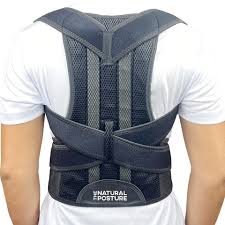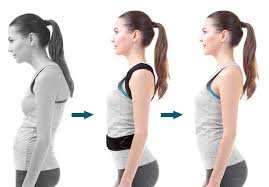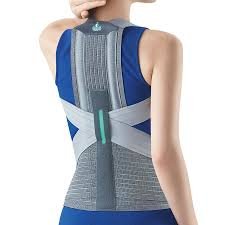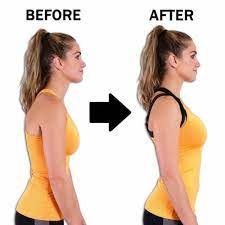Blog

Do posture braces work
Are you tired of feeling like a hunchback person after hours of sitting at your desk or gaming? If you’re nodding in agreement, you’re not alone. Poor posture is a common issue that affects many people today, leading to discomfort and even pain. As we dive deep into the world of health and wellness topics for employees, one solution stands out: posture braces. But do they actually work?
In this post, we’ll explore what posture braces are all about, uncovering the science behind posture correction while also highlighting their benefits. We will discuss different types available on the market and help you choose the right one for your unique needs. Plus, we’ll share useful tips on how to use them effectively so you can finally say goodbye to slouching.
Whether you’re struggling with rounded shoulders or wondering if bad sitting posture can cause chest pain, there’s something here for everyone seeking better alignment and comfort in their daily lives. Let’s get started!
What are Posture Braces?

Posture braces are supportive devices designed to encourage proper alignment of the spine and shoulders. They gently pull your body into a more natural position, combating the effects of poor posture.
Typically made from materials like elastic or neoprene, these braces can be discreetly worn under clothing. They come in various designs, catering to different needs—some focus on the upper back while others support lower back alignment.
Many people use them throughout their daily activities, whether sitting at a desk or engaging in physical exercise. With an increasing awareness of health issues related to slouching, posture correctors have gained popularity among both office workers and fitness enthusiasts alike.
These devices may assist in retraining your muscles to maintain good posture over time—even when you’re not wearing them!
Benefits of Using a Posture Brace

Using a posture brace can significantly improve your overall comfort throughout the day. Many people find that wearing one alleviates discomfort associated with poor posture, such as neck and back pain.
A well-fitted brace provides gentle reminders to maintain proper alignment, which can be especially beneficial for those who spend long hours at a desk or gaming setup.
Incorporating a posture corrector while working out enhances performance by promoting optimal body mechanics. This leads to better strength training results and reduces the risk of injury.
Another advantage is increased confidence. Standing tall not only improves physical appearance but also impacts how you feel about yourself in social situations.
For individuals dealing with conditions like postural kyphosis, these braces offer targeted support during recovery, aiding in rehabilitation efforts without compromising mobility or daily activities.
Different Types of Posture Braces

Posture braces come in various types, each designed to target specific issues.
One popular option is the back support brace. This device provides extra lumbar support, making it ideal for those who sit for extended periods or lift heavy objects frequently.
Shoulder straps are another choice, helping correct slouching by pulling the shoulders back. They’re particularly beneficial for individuals with rounded shoulders or poor posture while gaming.
For more severe cases of postural kyphosis, a rigid posture correction brace may be recommended. These offer firm support and encourage proper spinal alignment over time.
There are customizable options that allow users to adjust tightness and positioning based on their unique needs. Choosing the right type can significantly impact comfort and effectiveness during daily activities or workouts.
How to Choose the Right Posture Brace for You

Choosing the right posture brace can feel overwhelming, but it doesn’t have to be. Start by identifying your specific needs. Are you dealing with rounded shoulders or a hunchback? Knowing your unique issue will guide your selection.
Next, consider the type of brace available. Some are designed for everyday wear while others cater to specific activities like working out or gaming. Look for options that fit comfortably under clothing if you plan on wearing them throughout the day.
Always check sizing charts and read reviews to find a reliable fit. A poorly fitted brace won’t provide the support you’re looking for and may even cause discomfort.
Consult with a healthcare professional if possible. They can recommend braces suited to your condition and ensure that you’re making an informed choice tailored just for you.
Tips for Properly Using a Posture Brace

To get the most out of your posture brace, start by wearing it for short periods. Gradually increase the duration as your body adapts. This approach helps prevent discomfort and allows your muscles to strengthen over time.
Make sure to adjust the fit of the brace according to your body shape. A snug but comfortable fit is essential for effective support without restricting movement.
Incorporate stretching and strengthening exercises into your routine while using a posture corrector. These activities can enhance its effectiveness and promote better muscle balance.
Pay attention to how you feel when wearing it during different activities, including typing or gaming. Adjustments may be necessary based on what feels comfortable and supportive.
Remember that a posture brace is not a permanent solution; it’s one tool among many in improving overall posture health.
Common Misconceptions about Posture Braces
Many people believe that posture braces are a quick fix for poor posture. While they can provide support, relying solely on them won’t correct underlying issues.
Another misconception is that wearing a brace will create dependency. In reality, these devices should be used alongside exercises to strengthen core and back muscles. This combination fosters long-term improvement rather than reliance.
Some think all posture braces are uncomfortable or unattractive. However, advancements in design have led to various options that blend comfort with style.
Others assume only those with severe problems need a brace. Yet, even individuals with mild postural concerns can benefit from using one during activities like gaming or working at a desk.
Many wonder if posture braces restrict movement too much. Most modern designs allow for ample mobility while still providing effective support when you need it most.
Alternative Ways to Improve Posture

Improving posture doesn’t rely solely on braces or corrective devices. Incorporating regular stretching into your daily routine can make a significant difference. Simple stretches targeting the neck, shoulders, and back help alleviate tightness.
Strengthening exercises are vital too. Focus on core muscles like your abs and lower back to provide stability for proper alignment. Pilates and yoga are excellent choices for developing strength while promoting flexibility.
Mindfulness practices also contribute to better posture. Staying aware of your body position throughout the day reduces slouching tendencies, especially during prolonged sitting sessions at work or gaming.
Utilizing ergonomic furniture is another effective strategy. Adjustable chairs and desks allow you to customize your workspace, supporting correct postural habits effortlessly.
Consider breathing techniques that encourage relaxed yet upright positioning. Deep breaths not only calm the mind but also open up the chest area, counteracting hunching behaviors over time.
Conclusion
Posture braces can be a valuable tool for those looking to improve their posture and alleviate discomfort associated with poor alignment. Understanding the different types available, along with how they work, is essential in finding the right fit for your needs. While these devices may not be a one-size-fits-all solution, they can significantly benefit individuals dealing with issues like postural kyphosis or rounded shoulders.
Combining the use of posture correctors with other methods—such as targeted exercises and proper workstation ergonomics—can lead to even greater improvements. It’s also important to remember that maintaining good posture while gaming or at work takes conscious effort and practice.
As you explore health and wellness topics, don’t underestimate the importance of proper posture in your overall well-being. Whether you’re addressing chest pain from slouching or seeking ways to stop hunching over a screen, taking proactive steps toward better body mechanics will pay off in both comfort and confidence.

